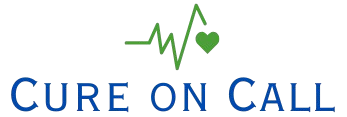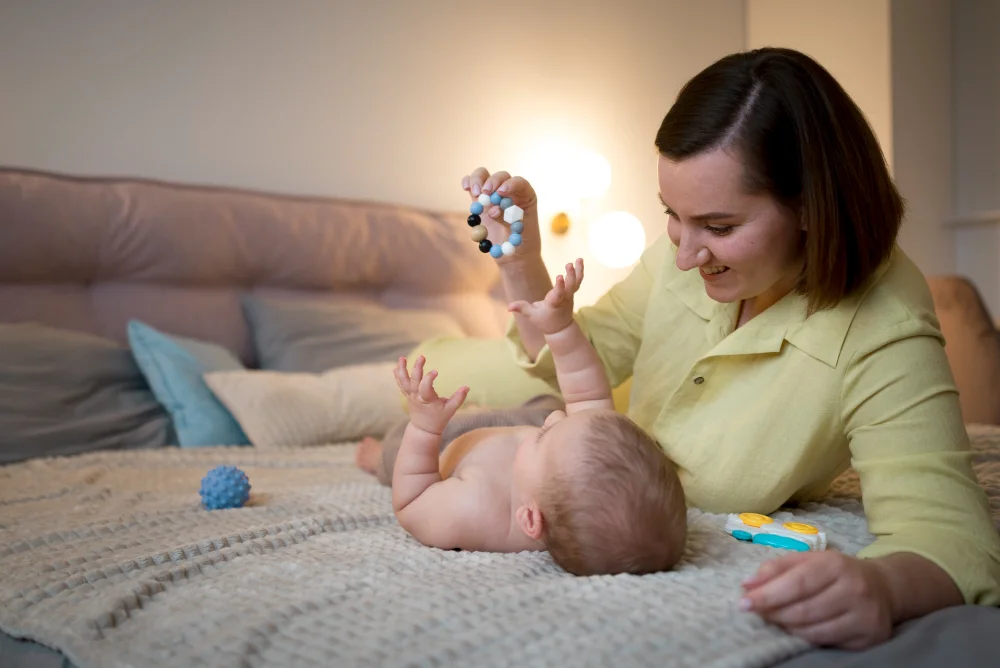Has your baby’s head started to look a little flat on one side, or do you notice them always tilting their head in the same direction? If so, you are far from alone. Many parents notice these changes during those early, sleep-deprived months and immediately worry they have done something wrong.
In reality, plagiocephaly (flat head syndrome) and torticollis (a tight, tilted neck) are very common, especially since the widespread and important recommendation for babies to sleep on their backs to reduce the risk of SIDS. Large organisations such as the NHS and the American Academy of Pediatrics emphasise that most cases are mild and improve over time, especially when simple positioning strategies and, where needed, physiotherapy are used.
This article brings together current evidence from paediatric physiotherapy research, guidance from leading bodies, and everyday clinical practice to explain, in clear language, how physiotherapy can help babies with plagiocephaly and torticollis, what treatment usually involves, and what you as a parent or carer can do right now at home.
Important: The information below is for general education and does not replace advice from your GP, paediatrician, health visitor, or physiotherapist. If you are worried about your baby’s development, vision, or movement, seek professional assessment promptly.
What Are Plagiocephaly and Torticollis?
Plagiocephaly (Flat Head Syndrome)
Plagiocephaly is a term used to describe a flattened or asymmetrical shape of a baby’s skull, usually at the back or on one side. Because babies’ skull bones are soft and still fusing, they can be moulded by constant pressure in one area.
UK resources such as the NHS and Great Ormond Street Hospital note that around one in five babies will show some degree of flat head at some point, and in the vast majority of cases it is cosmetic rather than harmful to brain development. Most mild cases improve as babies grow, sit, crawl, and spend less time lying on their backs.
Common signs include:
- A flat patch on one side or the back of the head.
- One ear appearing slightly further forward than the other.
- The forehead on the affected side looking a little more prominent.
Torticollis (Twisted or Tilted Neck)
Torticollis literally means “twisted neck”. In babies, the most common type is congenital muscular torticollis, where one side of the neck muscle (the sternocleidomastoid) is tighter or shorter than the other. This causes the baby to tilt their head towards the tight side and rotate it away.
Studies suggest that congenital muscular torticollis affects roughly 2–16% of newborns, depending on how it is defined and screened. Early identification is crucial because research shows that when physiotherapy starts in the first few weeks or months of life, most infants make an excellent recovery with conservative treatment alone.
Typical signs include:
- Baby often looking in one direction and having difficulty turning the head the other way.
- A consistent head tilt to one side.
- Preference for feeding on one side at the breast or bottle.
- Sometimes, a small lump or “muscle knot” can be felt in the neck muscle, especially in early infancy.
Why These Conditions Often Appear Together
Plagiocephaly and torticollis commonly go hand in hand. If a baby finds it uncomfortable or difficult to turn their head one way because of torticollis, they naturally rest with their head turned the other way most of the time. Over weeks and months, this constant pressure on one part of the skull can contribute to a flat patch and asymmetry.
This is where physiotherapy comes in. By addressing the neck tightness, improving range of movement, and teaching parents how to vary positions, physiotherapists can help tackle both the neck problem and the head shape together.
How Can Physiotherapy Help?
Paediatric physiotherapy for plagiocephaly and torticollis is gentle, play-based and focused on empowering parents. An evidence-based guideline from the American Physical Therapy Association highlights that there is strong evidence that earlier physiotherapy leads to better and quicker outcomes for congenital muscular torticollis. Many babies who start therapy within the first month or two of life regain near-normal neck movement within a fairly short treatment period.
1. Thorough Assessment and Individualised Plan
At your first appointment, the physiotherapist will typically:
- Take a detailed history of pregnancy, birth, sleep positions, and feeding habits.
- Observe your baby’s posture, head shape, and preferred head position.
- Gently assess neck range of motion, muscle tightness, and overall motor skills.
- Screen for any red flags that may need review by a paediatrician, orthopaedic surgeon, or neurologist (for example, concerns with vision, muscle tone, or delayed milestones).
Based on this, they will create a tailored treatment plan, usually combining hands-on techniques with a home exercise and positioning programme that fits into daily life.
2. Positioning and Handling Advice
Simple changes in how you position and carry your baby can make a surprisingly big difference over time. Many NHS leaflets and paediatric physiotherapists suggest strategies such as:
- Varying head position during sleep (while always keeping your baby on their back for sleep safety) by placing their feet at different ends of the cot on alternate nights, so they naturally turn towards the light or door in both directions.
- Changing the direction of toys and mobiles in the cot so that your baby turns towards their non-flattened, less preferred side.
- Reducing time on firm flat surfaces such as car seats and bouncers when not travelling, and using slings or upright holds to relieve pressure on the skull.
- Optimising feeding positions so your baby is encouraged to turn their head both ways at the breast or bottle.
These changes are often combined with specific positioning strategies to stretch the tight neck muscle gently during everyday activities such as cuddling, changing, and play.
3. Gentle Stretching and Range-of-Motion Exercises
A key element of physiotherapy for torticollis is gentle stretching of the tight sternocleidomastoid muscle and encouraging active movement into the more difficult direction. Techniques are always taught to parents so they can be carried out regularly at home.
For example, your physiotherapist may show you how to:
- Support your baby’s head and shoulders safely while slowly turning their head towards the tighter side within a comfortable range.
- Use side-lying positions to help your baby practise lifting and turning their head in the non-preferred direction.
- Incorporate stretches into routine tasks, such as nappy changing or after a bath, so they become part of the daily rhythm rather than a separate “exercise session”.
Research, including recent systematic reviews, indicates that consistent stretching combined with positioning and strengthening exercises leads to significant improvements in neck motion and head alignment for most infants with congenital muscular torticollis.
4. Tummy Time and Play-Based Strengthening
Tummy time is perhaps the single best-known strategy for both plagiocephaly and motor development. While awake and supervised, placing your baby on their tummy helps:
- Strengthen neck, shoulder, and trunk muscles.
- Take pressure off the back of the head.
- Encourage your baby to turn their head to explore their surroundings.
A large systematic review in Pediatrics found that tummy time is associated with better gross motor development and helps reduce the risk of brachycephaly (a different pattern of skull flattening). At the same time, more recent research suggests that tummy time alone may not completely prevent plagiocephaly in every case, which is why a combination of strategies and, if needed, physiotherapy is recommended rather than a single “magic” intervention.
If your baby dislikes tummy time, physiotherapists can demonstrate ways to make it more comfortable and enjoyable, for example:
- Starting with very short bursts (even 20–30 seconds) several times a day.
- Using your own chest or lap as a softer, more reassuring surface at first.
- Placing a rolled towel under the chest for support, or using high-contrast toys and mirrors to capture your baby’s attention.
5. Monitoring Progress and Adjusting the Plan
Physiotherapy is rarely a one-off session. Your baby’s therapist will usually review progress every few weeks, reassessing head shape, neck range of motion, and motor milestones. The programme is then adapted as your baby grows and gains new skills.
In some settings, physiotherapists work closely with paediatricians, orthotists, and other specialists. If the head flattening is severe or not improving despite good positioning and exercises, discussion about helmet therapy or further investigations may take place. Clinical guidelines tend to reserve helmet therapy for more severe, persistent cases and emphasise that even then, some degree of asymmetry is likely to remain.
What Does the Evidence Say?
Parents often want to know whether physiotherapy genuinely makes a difference or whether things would simply improve with time. Research over the past two decades gives encouraging answers, while also highlighting the importance of early, consistent intervention.
Evidence for Physiotherapy in Plagiocephaly
One well-known randomised trial of infants with positional preference showed that a structured programme of parental counselling and physiotherapy reduced the risk of severe deformational plagiocephaly by almost half at six months of age, with benefits persisting at 12 months. This supports the idea that early repositioning strategies and exercises are more effective than waiting to see what happens.
Systematic reviews of positional plagiocephaly highlight that:
- Back-sleeping is crucial for SIDS prevention and must not be abandoned, but it needs to be balanced with varied awake positioning and tummy time.
- Most mild cases improve spontaneously; physiotherapy can speed and support this process.
- Helmet therapy may offer additional improvement in selected severe cases, usually started around 6–7 months, but it is not required or appropriate for the majority of babies.
Evidence for Physiotherapy in Torticollis
For congenital muscular torticollis, evidence-based clinical practice guidelines and recent systematic reviews consistently report that:
- Early referral (ideally before three months of age, and even within the first month where possible) is associated with quicker resolution and fewer residual problems.
- Up to 90–95% of infants treated conservatively with physiotherapy achieve good to excellent outcomes without surgery.
- The typical programme combines stretching, strengthening, positioning, and parent education, rather than depending on one technique alone.
In short, physiotherapy is not simply about “rubbing the neck” for a few minutes; it is a structured, family-centred approach that supports the baby’s overall development and helps parents feel more confident and informed.
Practical Steps Parents Can Start Today
While nothing replaces individual assessment, there are several evidence-informed strategies you can begin straight away if you are concerned about a flat spot or a head-turning preference:
- Keep back-sleeping for all naps and night-time. This remains the safest position for reducing the risk of SIDS. Any repositioning should happen whilst your baby is awake and supervised.
- Increase supervised tummy time gradually. Aim to build up towards at least 30 minutes spread across the day, in short, manageable bursts that your baby can tolerate.
- Vary holding and carrying positions. Use upright carries, slings, and different sides of your body so that your baby is not always leaning on the same part of their head.
- Encourage turning towards the non-preferred side. Place toys, mobiles, and your own face on the side your baby finds harder to turn towards, so they are motivated to move in that direction.
- Alternate feeding sides. Whether breast or bottle feeding, try to position your baby so that they sometimes have to turn their head in their less preferred direction.
- Book an assessment with your health visitor, GP, or paediatric physiotherapist if you notice a persistent tilt or turning preference, or if the head shape seems to be worsening.
These steps are generally safe for most babies, but if you have any concerns about your child’s medical history (for example, heart problems, seizures, or neuromuscular conditions), seek specific medical advice before starting new exercises.
When to Seek Urgent Medical Advice
Although plagiocephaly and torticollis are usually benign and treatable, there are occasions when a more urgent medical review is important. Contact your GP or seek emergency help if:
- Your baby seems unusually floppy or stiff.
- There are concerns about vision, such as eyes not tracking together or a persistent eye turn.
- Your baby is not meeting expected developmental milestones (for example, not gaining head control, not smiling, or not using their limbs equally).
- There is a rapidly enlarging head, bulging soft spot (fontanelle), or repeated vomiting.
- The head shape looks very unusual from birth or is associated with ridges along the skull, which may suggest craniosynostosis (premature fusion of skull bones) rather than positional plagiocephaly.
In these cases, specialist assessment is essential and physiotherapy may be only one part of a wider diagnostic and treatment plan.
Frequently Asked Questions (FAQs)
1. Will my baby’s head ever look completely “normal”?
Many children with mild plagiocephaly have little to no noticeable flattening by school age, especially when early positioning and physiotherapy strategies are used. In more severe cases, a small degree of asymmetry may remain, but hair growth and overall head growth often make it far less obvious in everyday life.
2. Is physiotherapy painful for babies?
Physiotherapy for plagiocephaly and torticollis should not be painful. Stretches may feel slightly uncomfortable for a moment, and some babies protest simply because they dislike being positioned in unfamiliar ways. A skilled physiotherapist will work within your baby’s tolerance, using play, songs, and distraction to keep sessions as relaxed as possible.
3. Do all babies with plagiocephaly need a helmet?
No. Helmets are generally reserved for more severe cases that have not responded to repositioning and physiotherapy, or when the flattening is detected later in infancy. Even when helmets are used, they are usually only part of a broader treatment plan that still includes exercises and positioning. Many babies improve well without any helmet at all.
4. How long does physiotherapy treatment usually last?
The duration varies. Some babies with mild torticollis and plagiocephaly respond within a few weeks of consistent home exercises. Others, especially those referred later or with more marked asymmetry, may benefit from several months of follow-up. Your physiotherapist will review progress regularly and adjust the plan as needed.
5. Can I prevent plagiocephaly altogether?
It is not always possible to prevent plagiocephaly completely, particularly if there are underlying factors such as torticollis or prematurity. However, you can reduce the risk and severity by following safe sleep guidance, encouraging varied positions when awake, and seeking early advice if you notice a strong head preference or flat spot.
Key Takeaways
- Plagiocephaly (flat head) and torticollis (tilted or twisted neck) are common in babies and usually treatable.
- Physiotherapy plays a central role in managing both conditions through assessment, positioning, stretching, strengthening, and parent education.
- Evidence shows that early intervention leads to better, quicker outcomes and may reduce the risk of severe skull asymmetry.
- Simple strategies at home — such as increased tummy time, varied positioning, and encouraging head turning to both sides — can make a meaningful difference.
- Most babies improve significantly over time, and only a minority require more intensive treatments such as helmet therapy.
What Next?
If you are worried about your baby’s head shape or neck position, consider the following steps:
- Discuss your concerns with your health visitor, GP, or paediatrician and ask whether a referral to paediatric physiotherapy is appropriate.
- Begin gentle, supervised tummy time and simple positioning changes as described above.
- Keep a brief diary of your baby’s preferred head position, tummy time, and any exercises you try. This can be very helpful for your physiotherapist at the first appointment.
Over to you: Have you noticed a head-turning preference or flat spot on your baby’s head? What strategies have you tried so far, and what questions are still on your mind? Sharing your experiences and questions with other parents and with qualified professionals can be an important step towards feeling more confident and supported on this journey.
Read Also: How Physiotherapy Can Help with Sports Concussions




